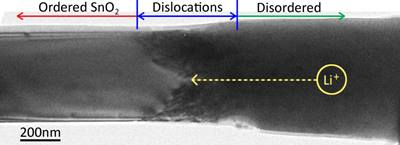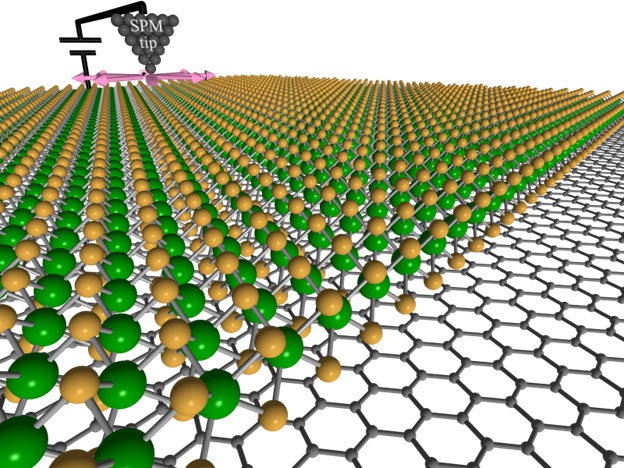The Twists and Turns of Battery Charging
January 19, 2011 :: The first ever real time movie of lithium ions charging a nano-sized battery may enable researchers to design safer, longer lasting, and more powerful batteries. To observe the charging, Jianyu Huang and John P. Sullivan, members of the multi-institutional
Science of Precision Multifunctional Nanostructures for Electrochemical Energy Storage EFRC led by the University of Maryland, and their collaborators, built a nanosized electrochemical device inside an electron microscope. It had a single SnO
2 nanowire anode, an ionic liquid electrolyte, and bulk LiCoO
2 cathode. The SnO
2 nanowire – a promising battery anode material – swelled, lengthened, and coiled as it charged but did not break apart like most bulk ceramic anodes. As the Li ions moved down the nanowire, dislocations (defects in the crystalline structure) formed just before the reaction front arrived. The dislocations may relieve stress so the brittle nanowire does not break, an important feature in battery materials expected to charge and discharge many times. They may also facilitate Li ions incorporating into the nanowire SnO
2, spurring the reaction to happen faster than in bulk material. This new atomic-scale time-resolved visualization capability will help researchers understand why battery materials degrade after charging and discharging many times and aid them in designing robust nanostructured lithium-ion batteries that are more powerful and lightweight.
Watch a video of the nanowire charging at
http://www.efrc.umd.edu/highlights/list.php?id=18

Reference:
Huang, Jian Yu; Zhong, Li ; Wang, Chong Min; Sullivan, John P.; Xu, Wu; Zhang, Li Qiang; Mao, Scott X.; Hudak, Nicholas S.; Liu, Xiao Hua; Subramanian, Arunkumar; Fan, Hongyou; Qi, Liang; Kushima, Akihiro; and Li, Ju,
In Situ Observation of the Electrochemical Lithiation of a Single SnO2 Nanowire Electrode,
Science,
330,
1515-1520 (
2010)
[DOI:10.1126/science.1195628].



